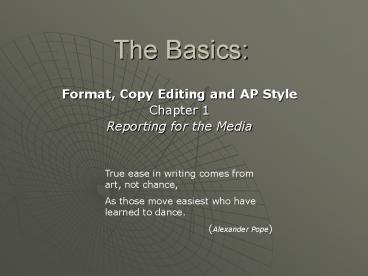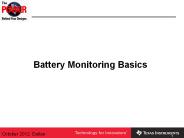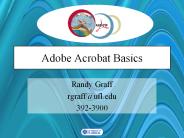The Basics: - PowerPoint PPT Presentation
1 / 46
Title:
The Basics:
Description:
(Carolyn Dawn Johnson) Dancing with Style. When we write, we dance with style. ... Or, we may write a simple, breaking news story. It could be a two-step or a waltz. ... – PowerPoint PPT presentation
Number of Views:34
Avg rating:3.0/5.0
Title: The Basics:
1
The Basics
- Format, Copy Editing and AP Style
- Chapter 1
- Reporting for the Media
True ease in writing comes from art, not
chance, As those move easiest who have learned to
dance. (Alexander Pope)
2
I think writing is like dancing, or playing the
piano, the more you do it, the more you keep up
with it, the better you get. Also, writing is one
of those things where if you stay practiced
you'll be ready when those great ideas come
along. (Carolyn Dawn Johnson)
3
Dancing with Style
- When we write, we dance with style. In this
class, we dance with Associated Press Style. - We may write a complicated feature. It may feel
like a tango. Or, we may write a simple,
breaking news story. It could be a two-step or a
waltz. But, each has a basic style. - In news writing, AP Style gives us charts of the
basic steps. - Journalists around the world recognize AP Style
and use the charts adapted by it.
4
One is these charts is a list of editing symbols
and you will find them inside the front cover of
your textbook. You can also access this list at
www.dibbs.net There is a list of copy-editing
symbols in your AP Stylebook Although there are
some variations between the lists, the marks you
will most often use are standard. These comprise
a language we will use to communicate what
changes need to be made.
5
- A few large newspapers, such as the New York
Times and The Washington Post, have published
stylebooks of their own. - Smaller papers, like the Press-Register, have
supplements for local style.
6
The INTRANET provides an excellent place for most
organizations to post their supplemental
stylebooks. The first edition of the
Press-Register stylebook was more than 10 years
in the making and was published as a booklet only
once.
7
- AP has a searchable stylebook on the Internet
- http//www.apstylebook.com/
- Students and professionals can subscribe.
8
Style Helps with Accuracy
- If it isnt accurate, it isnt news. Its
fiction. - Stylebooks are invaluable as guides for accuracy.
- Nothing is more embarrassing than a new reporter
writing about Dolphin Island, instead of
Dauphin Island. - Or, one wrote about Meyer Mitchell and used
Mayor Mitchell, as if he were the mayor.
9
Lets Dance
- Print has a style Basically, its writing for
the reader - Newspaper
- Magazine
- Broadcast has a style Writing for a reader
- Internet has a style Writing for the browser and
surfer
10
Suggested Web Site
- http//writing.umn.edu/docs/publications/irving20
fang.pdf - Writing Style Differences in Newspaper, Radio,
and Television News, a monograph by Irving Fang
of the University of Minnesota. A clear
discussion, along with examples of stories
demonstrating the differences in style.
11
Writing for The Reader
- Learn to write a GREAT Lead. All pieces of
writing should have a unifying theme or central
idea expressed in the lead. - After your reader is in, keep him there with
good transition. Make your copy flow.
Transition ties information together and tips the
reader off to what may come next. This is
narrative. This is story-telling.
12
Types of Transitions
- Connectors are simple words that help flow, in a
structural way. They help unify your writing. - Some examples are But, Or, Thus, However,
Therefore, Meanwhile, On The Other Hand. Dont
overuse these. - Hooks are words, or phrases, repeated to give the
reader a continual sense of unity in the story. - In an armed robbery story, you can use robbery,
robber, robbed, thief and theft several
times throughout a story.
13
Types of Transitions
- Use pronouns naturally to avoid repeating the
names of people or things too often. - Use similar ideas This was like It reminded
victims of within an article. - Use words or phrases that refer to a time Then,
Next, Later that day, When he came back, etc. - Numbering items within your writing will help tie
your information together. His first priority
was, secondly, thirdly, etc.
14
Characteristics of Print News
- Attribution telling readers where you got the
information for your story. - Attribution leads to credibility
- Information that is common knowledge does not
have to be attributed - The best of all attribution terms is said. He
said, she said, the mayor said, the captain said,
etc. - ATTRIBUTION IS A MUST
15
- Short sentences, short paragraphs paragraph
length should be kept to three sentences, or
fewer, and fewer than 100 words. - Third Person news stories are usually written in
the third person. - Here, you use the he-she form. As in he walked
down the alley, she picked up the phone, and
Jason told Tony he was going down, if he didn't
cough up the money. - An Attitude for Accuracy and Attribution
accuracy should be a state of mind for the news
writer, because if it isnt accurate, it isnt
news, its fiction.
16
The Inverted Pyramid
- The Inverted Pyramid concentrates important
information at the top of the story. - The LEAD is the focal point of a basic news
story. - The Second Paragraph expands on some of the
information presented in the lead. - The Body adds detail.
- But, the LEAD is the focal point of a basic news
story.
17
Quotes
- Use direct quotes sparingly.
- Direct quotes should supplement and clarify
information in your indirect quotes. - The correct sequence for a direct quote and its
attribution is Direct Quote, Speaker, Verb. - Example I do not choose to run, the nominee
said. - It should be MEMORABLE!
18
Editing and Rewriting
- ALL WRITERS NEED AN EDITOR!
- The first editing responsibility belongs to the
writer. - Copy editing involves various techniques and
operations that change and improve copy, without
altering basic structure and approach. - Rewriting means rewording large portions of the
copy and re-examining its structure.
19
Editing and Rewriting
- Style Check spelling, grammar, and AP style for
conformity. - Verbs Make sure verbs are active and
descriptive make sure they agree with subjects. - Wordiness Avoid using too many words.
- Answer all the questions Did you answer all the
Ws and the H of the story? - Internal consistency Make sure figures add up
properly, and times and dates are logical and in
AP style.
20
Feature Writing
- The main thing that sets feature stories apart
from news stories is the greater amount of detail
and description features contain. - Three major kinds of descriptions should be
contained in a feature story - Describe actions
- Describe people
- Describe places
- Feature stories contain more quotations and
dialogue than breaking news stories.
21
Features
- Profile people who make the news
- Explain events that move or shape the news
- Analyze what is happening in the world, nation or
community - Teach an audience how to do something
- Suggest better ways to live
- Examine trends
- Entertain
22
Types of Features
- Personality Profileswritten to bring an audience
closer to a person in or out of the news - Human Interest Storieswritten to show a subjects
oddity or its practical, emotional, or
entertainment value - Trend Storiesexamines people, things or
organizations that are having an impact on
society - In-depth storiesstories that require extensive
research and interviews - Backgroundersadds meaning to current issues in
the news by explaining them further explain how
countries, organizations, people etc. got to
where they are now.
23
Writing for Broadcast
- When you write broadcast copy, you write for A
reader. You write for an anchor, or an announcer.
24
Selection of News for Broadcast
- The following are some factors that broadcasters
use to select news - Timelinessthe most important news value in
broadcast news - Inform, not explainbroadcasters generally choose
stories that do not need a lot of explanation to
be understood by listeners - Audio or Visual Impactbroadcasters want stories
that their audience can hear and see stories are
often chosen because of sound and/or picture
availability.
25
Characteristics of Writing
- There are four Cs to broadcast journalism
- Correctnessor accuracy
- Clarityclear, precise language that contains no
ambiguity viewers cannot re-hear broadcast
newsthey must understand it the first time - Conversationalbroadcast news must sound more
conversational b/c people will be reading it
aloud - Colorwriting that allows the listener to paint a
picture of the story or event being reported
26
- News that is more than an hour or two old may be
considered stale. - The maximum length for almost any story is two
minutes the normal length is thirty seconds. - Slang and colorful phrasing is generally not
permitted in broadcast news. - Should be written in present tense as much as
possible. - Omit the time element in most news stories.
- Broadcast writers have to learn to produce in a
highly pressurized atmosphere deadlines are
imminent.
27
Story Structure
- Dramatic Structuremost common structure for
broadcast news it has three parts - Climaxgives the listener the point of the story
in about the same way the lead of a print news
story does it tells the listener what happened. - Causetells why the story happenedthe
circumstance surrounding the event. - Effectgives the listener the context of the
story and possibly some insight about what the
story means.
28
- Broadcast journalists think of their stories as
completed circles rather than inverted pyramids. - Stories must be written to fit into an amount of
time designated by the editor or news director. - Getting the attention of the listener is of top
importance in broadcast news! The first sentence
of a broadcast news story should be an attention
getter! - Broadcast news stories cannot go into the detail
and explanation that print or web stories can.
29
Broadcast Writing Style
- Conventions of Broadcast Writing
- Titles usually come before names.
- Avoid abbreviations, even on the second
referenceexcept familiar ones FBI and UN. - Avoid direct quotes if possible.
- Attribution should come before a quotation, not
after it. - Use as little punctuation as possible, but enough
to help the newscaster through the copy.
30
- Numbers and statistics should be rounded off
- Numbers one through nine should be spelled out
numbers 10 through 999 should be written as
numerals write out hundred, thousand, million,
billion, and use a combination of numerals with
these numbers where appropriate (i.e. 15-hundred) - Dont write a million, or a billion, but one
million, one billion
31
- COPY IS PREPARED FOR THE ANNOUNCER! Thus, there
are certain rules most news stations will employ
when preparing broadcast copy - Type only one story on a page and provide an
ending mark such as 30, at the end of the
page. - Use caps and lower case
- Dont carry over a paragraph to another
pagebegin the next page with a new paragraph - Dont hyphenate at the end of a line
- Indicate when tapes are coming into a story.
32
Characteristics/Qualities of the Web
- Immediacy once information is available in some
form, it can be loaded onto a Web site within a
few seconds - The Web does not require personnel or equipment
does not have any distribution problems - The Drudge Report Drudge taught newspapers and
magazines the importance of immediacy. A story,
which may have been an exclusive not only became
public, but became a question of good journalism.
33
- The actions of Newsweek Newsweek editors and
Matt Drudge on January 17, 1998, have been the
subject of many debates on journalism ethics and
practices they demonstrated the power of the
World Wide Web. - Permanency material on the web can remain in
place and accessible as long as the Web server
and electronic storage space exist. - Printed materials are certainly more lasting than
broadcasting, but their life and usefulness is
limited. With the Web, material can stay in place
as long as the host Web server and storage space
exists.
34
- Capacity The Web can keep and show huge amounts
of text and image materialthere are no limits
like there are in broadcasting and print. - Thanks to the Web (and other technological
advances) we can store more in smaller spaces and
centralize information. - Not only can a news Web site load a story about
an event, but it can also offer pictures, video,
audio, graphics, and more detailed text, like
sidebars.
35
- Interactivity The Web offers a level of
interactivity between producers and consumers
that goes far beyond print. - People have no control over what radio and
television stations broadcast, or what newspapers
print. - The technology of the Web offers a level of
interactivity between producers and consumers
that goes far beyond that. - Visitors can communicate directly through e-mail
or other means set up by the producers. - The Web remains a medium of Words, Images and
Sounds, especially WORDS. The Web needs people
who produce good, understandable text.
36
The Web Audience
- The Most Important Characteristics people of all
demographics expect and want from Web sites are
accuracy, accessibility.
37
Expectations for Web Sites
- Speed they should load quickly and their links
should respond instantly - Visual logic a web page should be easy to figure
out it should be clear what the web site is
about, what it contains, who produced it - Simple organization and navigation
- Depth they must contain enough information
- News they need to present new and updated
information
38
Creating Web Content
- Web writing follows the inverted pyramid style of
writing. - Web content should be accurate, complete, precise
and efficient. If it isnt accurate, it isnt
news. - Writers for the Web should use simple, clear
language unadorned with personal opinions or
personal writing style. Some of todays worst
writing is on the Web.
39
Concision
- A term that explains the need for precision and
concise Web text. - Elements of Concision
- Keywords bold face words that indicate the
information being presented often provide links
and/or are in bold print - Short Paragraphs 3 to 4 sentences at most
- Indentations help provide visual cues for
readers - Bulleted and numbered lists
40
Other Web Page Characteristics
- Background, details and lists
- Pictures
- Graphics
- Maps
- Documentssuch as court opinions, laws, policy
statements - Previous stories
- Audio and Video Clips
- Links to other web sites
- E-polls
- Discussion forums
41
- E-mail is now a tool of mass communication.
- E-mail newsletters are an increasingly popular
form of keeping people informed.
42
Marilyn Hotchkiss Ballroom Dancingand Charm
School
43
Writing to be UnderstoodAn altered version of
Lawrence Ferlinghettis poem The Poet
- Constantly risking absurdity and death, if he
performs above the heads of his audience, the
writer, like an acrobat, climbs on style to a
high-wire of his own making. - Then, balancing above a sea of faces, paces his
way to the other side of day, performing jumps,
style tricks, and other high theatrics, but never
mistaking anything for what it may not be. - For he is the super-realist, who must, perforce,
perceive taut truth, before each step or stance
in his advance toward a higher perch, where
beauty waits with gravity to start her
death-defying leap. - And, he is the little Charlie Chaplin man, who
may, or may not, catch her fair, spread-eagle
form in the empty air of existence.
44
I went to a dance class. Why a dance class? A man
bought me a ticket.
- When you and style find each other, it will be a
new beginning a fresh start. - Memories are hard, because they involve habits.
Habits are hard to break. - Youve come to writing (dance) class as a favor.
Someone, maybe you, bought a ticket. - Youre looking to deliver a message.
- On the way, you may find something else. You may
find the beauty of narrative. - But, what if that beauty is not there at the end
of your journey? - Oh, dont worry. Shell be there.
45
- You are human
- Use AP Style
- Get names right
- Check facts
- Learn grammar
- Write simply
- Use the right word
- Keep sentences short
- Listen, listen, listen
- Use unforgettable quotes
- Think write
- Write - rewrite
- Be original, not trite - rewrite
- Write about people
1, 2, 3 Repeat Youre Waltzing
46
(No Transcript)































